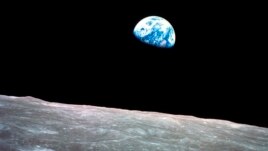12 November 2023
Scientists have recognized since the 1970s that there are two large, mysterious blobs in the deepest part of Earth's mantle.
One of the masses is under Africa and the other under the South Pacific Ocean.
Recent research suggests these masses, which are denser than the material surrounding them, might be from a huge crash early in our planet's history.

FILE - This Dec. 24, 1968, file photo made available by NASA shows the Earth behind the surface of the moon during the Apollo 8 mission. (William Anders/NASA via AP, File)
Researchers recently said the crash between Earth and a Mars-sized object called Theia might have created the moon.
Recent research suggests the event happened more than 4.46 billion years ago. Pieces of Theia, however, might have remained inside Earth, sinking to an area just above our planet's hot core of iron and nickel.
Researchers created computer simulations to study their theory of the event. Based on these simulations, they proposed that most of Theia was absorbed into Earth, forming the two masses, while the remaining pieces formed the moon.
Qian Yuan is a geophysicist at Caltech and the lead writer of the study that was published recently in Nature.
"The bottoms of these blobs are 2,900 kilometers below our feet. The two blobs are about 2 percent of Earth's mass. They were detected by seismology as seismic waves travel slower within these two regions compared to the surrounding mantle. Each of the blobs are twice the mass of the whole moon. So, the blobs are massive," Yuan said.
If the theory is correct, these two masses would represent evidence of the possible moon-forming crash.
Caltech professor and study co-writer Paul Asimow said there has not been agreement "on whether we can find evidence for this event not just in the moon but also in some observable property of the modern Earth."
The two masses, Asimow added, are the biggest difference "in Earth structure from a simple layered planet."
Study co-writer Hongping Deng of the Chinese Academy of Sciences' Shanghai Astronomical Observatory said, "It is incredible because we can uncover relics of another planet - Theia - if we dig deep enough in Earth's mantle."
The increased density of the masses is believed to come from their high level of iron. Moon rocks also contain high iron levels. So, the researchers think it would make sense if they came from the same place: Theia.
The moon, which orbits Earth at an average distance of about 385,000 km, has a diameter of about 3,475 km, a bit more than a quarter of our planet's diameter.
Asimow said that, if the theory is correct, some volcanic rocks that reach Earth's surface might provide pieces of Theia.
"If our model is correct, the blobs should have isotopes - trace elements - that are similar to the lunar mantle rocks, which can be tested in future lunar missions," Yuan said.
Gaining a greater understanding of the hypothesized giant impact could provide information concerning the evolution of Earth and other rocky planets in our solar system and beyond it.
"Earth is still the only confirmed habitable planet, and we do not know why," Yuan said. He added the crash set the early conditions for Earth's development and said: "Studying its consequences may help us to figure out why Earth is different than other rocky planets."
I'm John Russell.
Will Dunham reported on this story for Reuters. John Russell adapted it for VOA Learning English.
__________________________________________________
Words in This Story
blob -- n. (informal) something that does not have a regular shape
mantle -- n. the middle layer of the Earth that is between the top crust and the inner core
core –n. the central part of something, such as the Earth
simulation -- n. something that is made to look, feel, or behave like something else
absorb –v. to take in some substance, especially a liquid
seismology -- n. the scientific study of earthquakes
relic -- n. something that is from a past time or place
isotope -- n. any one of various forms of the same chemical element
trace –adj. existing in small amounts
habitable –adj. able to be lived in; able to support life
consequences –n. (pl.) the results of an event or a decision